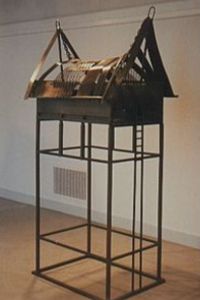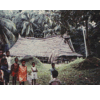
"Haus Tambaran, Sepik River, New Guinea."
Steel. 1989.
86" x 43" x 36".
|

|
Subject
Every village in the Sepik River of New Guinea possesses one Haus
Tambaran, literally Spirit House, for each clan in the village.
The distinguishing feature of the structure is the saddle roof,
which has major structural significance, as well as relating to
the origins of the peoples of the Sepik River. The other dominant
feature of the Haus Tambaran, as of all Sepik structures, is the
placement of the building on stilts.
Object
When I visited the Sepik River in 1982, the flooding of the river
made the placements of the structures on stilts the major visual
feature of the buildings. This is therefore the basis for the
sculpture "Haus Tambaran, Sepik River, New Guinea."
Although the impression was strong, it was not until 1988, that
I was able to convert this image into sculpture. This was because
over the previous 6 years, I had been consciously moving from
a minimal to a more figurative approach to sculpture. However,
I still aim to retain a strong minimal economy in my work, because
I believe that all art movements have something to offer the production
of art.
The sculpture addresses the elevation of the Haus Tambaran on
stilts, and its most dominant visual image, the roof structure.
The roof curve is a pure tension element form which equates to
that of a hung chain, which is therefore used in the sculpture
to serve as the ridge of the roof.
|
|
